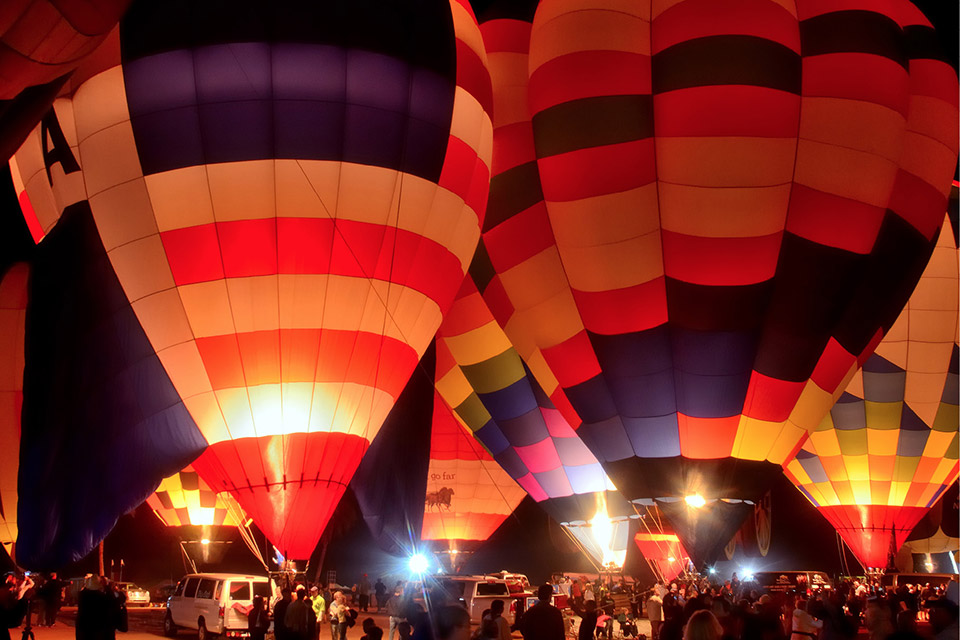Whenever a hot air balloon flies over a river, pond, or lake, chances are that it will descend toward the water’s surface to perform a “splash and dash”—ballooning’s equivalent of a touch-and-go landing. The objective is to touch the water with the bottom of the balloon’s basket, and then ascend. If the pilot misjudges, however, all the passengers end up with wet shoes.
An annual balloon festival in Lake Havasu City, Arizona, takes that connection between balloons and water and turns it up a notch.
“The Lake Havasu Balloon Festival is a really magical place to fly because we have blue water running through the desert. It’s beautiful, and a really majestic place to fly balloons,” said Dean Baker, a local balloon pilot. “And we have a unique safety feature. If you get caught over the lake, we have boat captains trained in how to pull hot air balloons back to shore.”
Gary Moore of Lake Havasu City, a hot air balloon pilot since 1992, was asked to help launch the Havasu Balloon Festival and Fair in 2011; January will mark its sixth anniversary. Moore—who has flown at events in 40 of the 50 United States, and in 19 countries—incorporated the best aspects from each of those festivals.
“I was the only balloonist in town at the time,” recalled Moore, who helped members of the local Lions and Rotary clubs plan the event. “I wasn’t the balloonmeister the first year, but they kind of rope you into it,” he laughed.
And Moore quickly got help from people like Baker, a private pilot and owner of a local real estate firm. Baker, who has owned several airplanes, took his first hot air balloon ride at the inaugural festival. “I just fell in love with hot air balloons,” Baker said. “I was hooked after that one ride. I liked it so much that I sold my Bonanza and bought a hot air balloon.
“It’s just such a unique way to enjoy aviation,” he added. “What I love most about hot air balloons is that there’s a $300 annual, and you get to take it home and put it in your garage—so no hangar fees.” Baker, who has replaced his original balloon with a larger one, now handles marketing for the event.
The first Havasu Balloon Festival and Fair drew 20 balloons. Its fifth iteration, held January 16 to 18, 2015, brought 78 balloons to an island that can be accessed only by driving over the London Bridge (yes, the one disassembled and moved from the United Kingdom that, since 1971, has connected Lake Havasu City with an island resort); by boat; or by hot air balloon. Some 20,000 people attended the festival, which raised about $125,000 for local charities.
The event’s unique location “is a pretty good draw,” Moore noted, with desert terrain surrounded by mountains and bisected by the Colorado River and Lake Havasu. Pilots are intrigued by volunteer local boaters, who receive special training in towing balloons and will retrieve those that drift too far over—or all the way across—Lake Havasu. “Everyone wants to get a picture of their balloon over the London Bridge,” Moore said. “And a lot of people are coming out of areas that don’t have decent weather this time of year. Overall we’ve got things dialed in pretty good.”
Last year, pilots came from around the western United States, and as far away as Missouri and Illinois—as well as Belgium, Canada, England, Germany, and New Zealand. “We have a lot of them that have been here all five years,” he said. “We provide a good pilots’ tent with breakfast and a meal each evening.” Participation is by invitation only, because space on the island is limited, and there’s a waiting list of 100 pilots. “We stress safety, and the best way to do that is to surround yourself with good pilots—pilots you can trust,” Moore said.
One of those pilots is Robin McWilliams from Cypress, California, who has flown at Lake Havasu for three years. She and her husband, Mike, prefer to launch near the tip of the island, so they can fly over London Bridge. “If you stay down low, you can get the wind current and follow along the water,” Robin McWilliams said.
Another plus? The ability to splash and dash. “They don’t let you splash and dash at Temecula [California],” Mike McWilliams noted. (At one pilots’ briefing, a balloonist was recognized for overdoing the maneuver and fully dunking his basket in the water. He was presented with a life preserver.) The McWilliamses fly only about once a month at home, he added. “You’ve got to drive 90 miles to wherever you’re going to fly. [Los Angeles] has gotten too dense.”
“If there’s a lot of money in ballooning, I think I put it there,” laughed Pat Nilz of Marana, Arizona. He owns 11 balloons—including balloons in the shapes of a cactus, globe, and witch. “My son’s flying now—that’s a blessing. He’s won three races. He started as a baby—he’s been flying with us his whole life.”
Bill Armstrong of Cortez, Colorado, has been ballooning for about five years. “It’s all nice people, and it’s a very social thing. A ballooner can be a pilot, but he can’t fly it by himself.” In Lake Havasu City, Armstrong was crewing for Nilz. “It’s a peaceful way to get in the air. The flying isn’t as exciting as airplanes, but it stirs me.”
Armstrong had just sold his Cessna 182 to his nephew, and was building a Zenith STOL CH 701. “I don’t need cross-country transportation, I just need to fly,” he explained.
Before dawn, during breakfast in the pilots’ tent, that social aspect made it challenging for balloonmeister Moore to quiet the crowd for the briefing. “Please don’t block streets any longer than you have to,” he reminded them after providing the weather. “The streets here are very wide and there are no power lines on most of them—they run behind the houses.”
It didn’t help that Moore was hoarse after several days of festival briefings. “Do not take off or land on the London Bridge! It’s the only access to and from the island, and it needs to be kept clear for emergency vehicles.”
Local conditions sometimes give Lake Havasu City characteristics similar to those of the famous “box” in Albuquerque, New Mexico, home of the Albuquerque International Balloon Fiesta—widely regarded to be the world’s largest hot air balloon festival (see “The Air Up There,” October 2010 AOPA Pilot). There, under the right conditions, wind currents circulate and allow balloonists to circle the launch field.
Lake Havasu’s currents usually are more subtle. “Sometimes it’s a very, very thin layer and if you keep your rate of descent very, very slow, you can use those currents to steer,” Moore explained. “Albuquerque is the mecca of balloonists. We’re becoming the mini-mecca.”
Winds permitting, each day of the Havasu Balloon Festival concludes with a balloon glow: Balloonists inflate their crafts and then illuminate them with bright blasts of flame from their powerful propane burners. The popular evening events are always well attended, frequently with larger crowds than the morning launches—although to be fair, not all pilots launch from the island; many choose to launch from locations in the city that will allow them to land on the island.
After fantastic weather at the 2015 event, Moore was hoping for good weather this year. “We did 10 out of 10 [scheduled] inflations—that’s just unheard-of amazing. Good weather makes you look like a hero,” he said.
The Sixth Annual Havasu Balloon Festival and Fair will be held January 15 through 17, 2016, in Lake Havasu City, Arizona.
Email [email protected]











